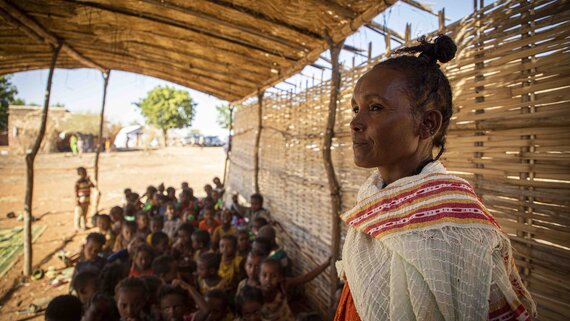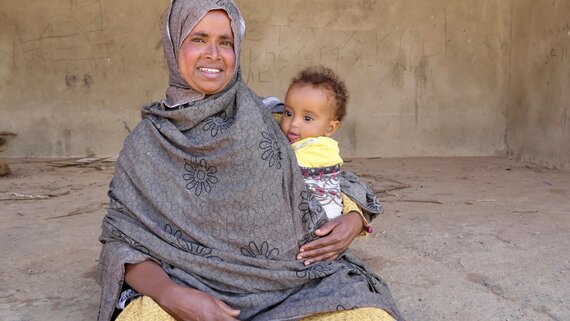Analysis of the context, crisis and needs
A significant portion of Ethiopia’s population urgently needs humanitarian support, with armed conflict, climate shocks (including drought and flooding), disease outbreaks, a desert locust invasion and the continuing socioeconomic impacts of COVID-19 undermining the significant development gains made over recent years.
The impacts of frequent and extreme weather events continue to negatively affect access to food from cultivated crops, access to land for pasture, livestock production and market functionality. Several hundred thousand people are typically displaced each year due to floods, and on average approximately 3 million people experience crisis levels of food insecurity due to poor rains or drought conditions each year. Displacement caused by the intensification and expansion of the conflict in northern Ethiopia in addition to long-standing intercommunal tensions and regional border disputes are the main drivers of humanitarian needs. The displacement trend has increased over the last three years, rising from 3.2 million internally displaced persons (IDPs) recorded in 2018 to 4.2 million at the end of 2021.

Gijet, Ethiopia
A health worker evaluates a child during a malnutrition screening in Gijet, Tigray region. The crisis in northern Ethiopia has left millions of people in need of emergency assistance and protection. Access to communities is hindered by the limited availability of fuel, telecoms, supplies, shipments and cash to run humanitarian operations.
UNICEF/NesbittDisplaced people generally have limited access to nutritious food, protective shelter, safe water and sanitation facilities, as well as basic services to meet their basic needs. Displacement contributes to and exacerbates protection risks, including risks in relation to sexual and gender-based violence; family separation, including unaccompanied and separated children, or elderly persons or persons with disabilities who may be left behind during periods of displacement; housing; land and property issues; loss of civil documentation; and livelihoods concerns. In areas of displacement, elevated socioeconomic poverty further increases the risk of sexual and gender-based violence, particularly for women and girls. In situations of displacement, elderly persons and those living with disabilities may experience abandonment, neglect and unequal access to basic services, notably food and health care. Inability to access education directly impacts displaced children’s safety and well-being.
Projected situation in 2022
Climate shocks, conflict, insecurity and disease outbreaks coupled with a deteriorating economy will continue to exacerbate humanitarian needs in 2022 for 25.9 million people. Latest available reports of observed and projected short-term rainfall offer a pessimistic outlook. Seasonal forecasts published in September 2021 indicate high confidence that the deyr/hageya season (October to December) will see below-average rainfall in the country’s low-lying and southern parts. This would represent a third consecutive poor rainy season, increasing the risks of poor crop performance, the deterioration of livestock conditions and productivity, as well as water shortages for human and animal consumption. The far-reaching humanitarian impacts of armed conflict will continue to affect communities in 2022 across the north of the country and in several other hotspots. An inability to respond at the levels needed will result in further displacement, exacerbate living conditions for existing IDPs and others in vulnerable situations and increase protection risks, including those linked to negative coping mechanisms.

Al Qadarif, Sudan
This teacher is one of the Ethiopian refugees who volunteered to teach children in makeshift classrooms at Um Rakuba camp. Clashes between the Ethiopian army and forces from the Tigray region have driven thousands of people to flee their homes – more than half of them are children. Since the fighting began in early November 2020, thousands of refugees have fled into Sudan to find safety. "These children are the next generation coming up. Some will be doctors, teachers, pilots. I don't just dream for them… teaching plays a role in building a generation.”
UNHCR/Will SwansonThe deepening protection crisis is expected to remain a core driver of humanitarian need, as many Ethiopians continue to flee their homes due to conflict, intercommunal tensions, climate shocks or other factors. Protection concerns are growing, particularly for groups already at risk, including children, women, elderly persons and persons with disabilities, as families lose their socioeconomic and community-support structures. These concerns are being further aggravated by reduced levels of humanitarian access in many areas.
At the end of 2021, there were an estimated 4.2 million IDPs in Ethiopia, with high levels of need also identified among non-displaced people living in conflict-affected areas. Many IDPs have sought shelter in urban areas, further increasing pressure on vulnerable families within host communities. Many are living in overcrowded settlements, at heightened risk of gender-based violence, marginalization, exclusion, health outbreaks, economic hardship or lack of access to basic services. Violations against children are likely to continue, particularly among the 1.7 million displaced children who are out of school and exposed to heightened protection risks. In the absence of peace and stability, people who were already at risk and marginalized will experience heightened exposure to insecurity and related protection concerns.

Kebribayah, Ethiopia
This woman was born in eastern Ethiopia 25 years ago to Somali parents. Violence in Somalia prompted them to seek shelter across the border. She has never stepped foot inside Somalia and never left Somali region, where her parents settled. She lives in the Kebribayah refugee camp. Established in 1991, it is Ethiopia’s oldest camp and home to 15,000 refugees, mostly Somali. For as long as she can remember, she has received food assistance from WFP. It has become a source of stability and familiarity in her life.
WFP/Edward JohnsonIn 2021, humanitarian access in Ethiopia became more complex due to insecurity related to the conflict in the north as well as in other parts of the country. Current levels of violence and armed conflict are unprecedented in Ethiopia’s recent history. They constitute a major impediment to relief operations, preventing millions of people from accessing assistance and further eroding their resilience, while at the same time increasing the need for humanitarian support.
Response priorities in 2022
The response priorities for 2022 will primarily focus on multisectoral life-saving and life-sustaining assistance, protection services and resilience-building to support at-risk and vulnerable people, particularly women, children, elderly persons and people with disabilities. People with the most acute humanitarian needs and those in the most life-threatening situations will be prioritized. They include IDPs, returnees, relocated persons, returning migrants and communities directly affected by humanitarian shocks. These population groups will be supported with essential protection and conflict-sensitive services. Given the growing levels of food insecurity due to persistent droughts coupled with the desert locust infestation, particular efforts will be made to scale up operations to address malnutrition and avert extreme hunger, and to mitigate the risk of people being forced to resort to negative coping mechanisms. The response strategy is prioritized around the convergence of geographical hotspots and the severity of need, while placing protection and affected people at the centre of the collective response.
Ethiopia HRP
The HRP prioritizes 22.3 million people living in conflict- and climate-affected woredas (districts) presenting the highest levels of severity of need. In particular, IDPs and non-displaced climate- and conflict-affected people will be targeted with urgent life-saving humanitarian assistance and protection services, with a particular focus on the most vulnerable women, girls, boys, elderly persons and persons with disabilities presenting extreme or catastrophic levels of humanitarian need. In addition, displaced and non-displaced population groups, including IDPs, returnees, relocated persons and migrants, presenting severe humanitarian needs will be targeted through multisectoral response by strengthening access to basic services, preventing further deterioration of their humanitarian status and supporting their resilience.
References
- The People in Need figure is indicative. The final figures will be reflected in the final HNO and HRP, and in subsequent GHO updates.
- Ibid.



